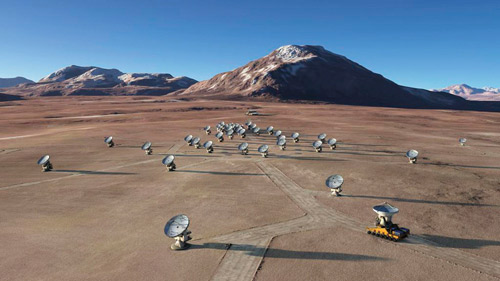After more than ten years of design and construction by scientists and engineers across the globe, the Atacama Large Millimetre/submillimetre Array (ALMA) has passed a key milestone, known as ‘phase closure’, crucial for the high quality images that will be the trademark of this new tool for astronomy. Engineers and astronomers have, for the first time, successfully linked three of the observatory’s antennas at the 5,000 m elevation observing site in northern Chile.
ALMA, an international astronomy facility, is a partnership of Europe, North America and East Asia in cooperation with the Republic of Chile. The successful linking of the antenna trio was a key test of the full electronic and software system now being installed, and its success anticipates the future capabilities of the observatory. When complete, ALMA will have at least 66 high-tech antennas operating together as an ‘interferometer’, working as a single, huge telescope, with an effective diameter exceeding 10 miles, probing the sky in the millimetre and submillimetre wavelengths of light.

The combination of the signals received at the individual antennas is crucial to achieve images of astronomical sources of unprecedented quality at its designed observing wavelengths. The three-antenna linkup is a critical step towards the observatory’s operations as an interferometer. Although the first, successful measurements employing just two antennas were obtained at the ALMA high site from October 2009, the addition of the third antenna is a leap of vital importance into the future of the observatory. Several additional antennas will be installed on the Chajnantor plateau over the next year and beyond, allowing astronomers to start producing early scientific results with the ALMA system around 2011.
